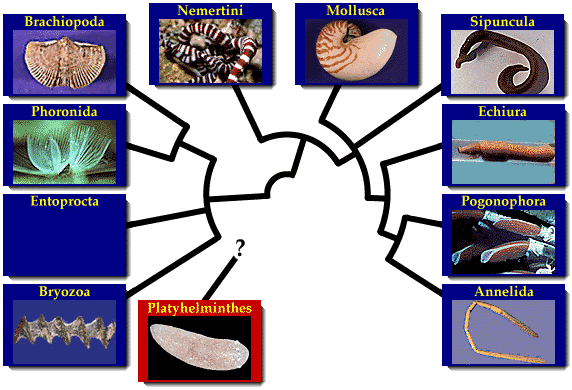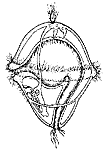
The Lophotrochozoa comprise one of the major groups within the animal kingdom, In turn, the Lophotrochozoa belongs to a larger group within the Animalia called the Bilateria, because they are bilaterally symmetrical with a left and a right side to their bodies.

The cladogram above shows the major groups in the Lophotrochozoa. Click on any box containing a picture to learn about that particular group. The phylogeny above is based on a combination of morphology and 18S RNA. It is not the final word on the relationships between these groups, and there are many competing hypotheses. For now, we prefer this grouping based on the available evidence, but as data continues to accumulate our picture of the relationships may change.
The name Lophotrochozoa comes from the names of the two major animal groups included: the Lophophorata and the Trochozoa. In the cladogram above, you can see this division. Those animals to the left side of the cladogram are the Lophophorata, while the groups along the top and right side (Nemertini through Annelida) belong to the Trochozoa.
 Trochozoa:
These animals are all protostomes -- the mouth
develops before the anus in the young embryo -- and they have long been
recognized as belonging together as a group. Many of the members are
worm-like, though not all of them are familiar or common. The two largest
groups of trochozoans are the Mollusca
(molluscs) and the Annelida (segmented
worms).
Trochozoa:
These animals are all protostomes -- the mouth
develops before the anus in the young embryo -- and they have long been
recognized as belonging together as a group. Many of the members are
worm-like, though not all of them are familiar or common. The two largest
groups of trochozoans are the Mollusca
(molluscs) and the Annelida (segmented
worms).
It might seem strange at first to group earthworms and squid together. They certainly don't look much alike, but that is only true when looking at the adult form; there is a fundamental feature of their life history that they share. Many annelids and molluscs share patterns of development in early embryonic stages. When these larvae hatch, each is a microscopic swimmer known as a trochophore larva, shown at right. The larva has two bands of cilia around the middle that are used for swimming and for gathering food, and at the "top" is a cluster of longer flagellae. So the larvae of these groups is nearly identical, even though they mature into very different adult forms. Until very recently, the Arthropoda (insects & crustaceans) were considered possible close relatives of the Annelida, based on the fact that both groups are segmented, but no arthropod has a trochophore larva and no molecular studies support a close relationship.
Lophophorata: This group includes the Phoronida and Entoprocta (both small groups) as well as the Bryozoa ("moss" animals) and Brachiopoda (brachiopods), both of which have an extensive fossil record. The feature shared by this group is the lophophore, an unusual feeding appendage bearing hollow tentacles.
While the Lophophorata are a well-recognized group, phylogenetic studies do not yet agree on the identity of their closest relatives. These animals were once included in the Pseudocoelomata, because they do not have a distinct internal body cavity like the Trochozoa, but this grouping does not hold together in modern studies. We have placed the Lophophorata in the Lophotrochozoa as the most popular of the current choices in the literature, but there are studies that suggest they may belong with the deuterostomes, or may even be paraphyletic.

Sources:

